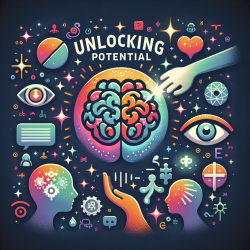Understanding Eye Gaze in Autism: Insights for Practitioners
As practitioners dedicated to improving outcomes for children with autism spectrum disorder (ASD), understanding the nuances of social interactions is crucial. A recent study titled Look me in the eyes: constraining gaze in the eye-region provokes abnormally high subcortical activation in autism sheds light on the complex relationship between eye gaze and subcortical activation in individuals with ASD.
Key Findings
The study utilized functional MRI to investigate how constraining gaze to the eye-region during dynamic emotional face perception affects subcortical activation in individuals with ASD compared to typical controls. The results revealed that when individuals with ASD are forced to look into the eyes, there is an abnormally high activation in the subcortical system, including the superior colliculus, pulvinar nucleus of the thalamus, and amygdala. This heightened activation may contribute to the discomfort and avoidance of eye contact often observed in individuals with ASD.
Implications for Practice
These findings offer valuable insights for practitioners working with children with ASD. Here are some strategies to consider:
- Progressive Habituation: Gradually introduce eye contact in a controlled manner to help children with ASD become more comfortable with direct gaze. This approach can be likened to desensitization techniques used in other therapeutic contexts.
- Incentivize Eye Contact: Use positive reinforcement to encourage eye contact during social interactions. This can help make the experience more rewarding and less stressful for the child.
- Focus on Emotional Context: Tailor interventions to consider the emotional context of eye contact. Recognize that different facial expressions can elicit varying levels of activation and stress in children with ASD.
Encouraging Further Research
While this study provides important insights, it also highlights the need for further research. Understanding the neural mechanisms underlying eye gaze in ASD can inform the development of more effective therapeutic interventions. Practitioners are encouraged to stay informed about ongoing research in this area and consider participating in studies that explore the impact of eye gaze interventions on social and emotional outcomes in children with ASD.
Conclusion
The study underscores the complexity of eye gaze in autism and its implications for social interaction and emotional processing. By integrating these insights into practice, practitioners can better support children with ASD in developing critical social skills. For those interested in delving deeper into the research, the original study offers a comprehensive analysis of the findings and their potential applications.
To read the original research paper, please follow this link: Look me in the eyes: constraining gaze in the eye-region provokes abnormally high subcortical activation in autism.










